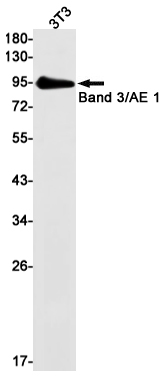Band 3 Recombinant Rabbit mAb
Cat No.: ARM1694
 Size:
Size:

| Product Name: | Band 3 Recombinant Rabbit mAb |
| Cat No.: | ARM1694 |
| source: | Rabbit |
| reactivity: | Human |
| applications: | WB,IHC,ICC/IF |
| clonality: | Monoclonal |
| recommended dilution: | WB,IHC,ICC/IF |
| format: | Liquid |
| isotype: | IgG |
| immunogen: | A synthetic peptide of human Band 3 |
| calculated molecular weight: | 102 kDa |
| observed molecular weight: | 102 kDa |
| genbank accession number: | P02730 |
| gene id (ncbi): | 6521 |
| purification method: | Affinity Purification |
| conjugate: | Un-conjugated |
| storage: | Store at -20°C. Supplied in 50nM Tris-Glycine(pH 7.4), 0.15M NaCl, 40%Glycerol, 0.01% sodium azide and 0.05% BSA. Stable for 12 months from date of receipt. |
| synonyms: | DI; FR; SW; WD; WR; AE1; CHC; SAO; WD1; BND3; EPB3; SPH4; CD233; EMPB3; RTA1A |
| category: | Primary Ab |
| concentration: | 1mg/ml |
| background: | The protein encoded by this gene is part of the anion exchanger (AE) family and is expressed in the erythrocyte plasma membrane, where it functions as a chloride/bicarbonate exchanger involved in carbon dioxide transport from tissues to lungs. The protein comprises two domains that are structurally and functionally distinct. The N-terminal 40kDa domain is located in the cytoplasm and acts as an attachment site for the red cell skeleton by binding ankyrin. The glycosylated C-terminal membrane-associated domain contains 12-14 membrane spanning segments and carries out the stilbene disulphonate-sensitive exchange transport of anions. The cytoplasmic tail at the extreme C-terminus of the membrane domain binds carbonic anhydrase II. The encoded protein associates with the red cell membrane protein glycophorin A and this association promotes the correct folding and translocation of the exchanger. This protein is predominantly dimeric but forms tetramers in the presence of ankyrin. Many mutations in this gene are known in man, and these mutations can lead to two types of disease: destabilization of red cell membrane leading to hereditary spherocytosis, and defective kidney acid secretion leading to distal renal tubular acidosis. Other mutations that do not give rise to disease result in novel blood group antigens, which form the Diego blood group system. Southeast Asian ovalocytosis (SAO, Melanesian ovalocytosis) results from the heterozygous presence of a deletion in the encoded protein and is common in areas where Plasmodium falciparum malaria is endemic. One null mutation in this gene is known, resulting in very severe anemia and nephrocalcinosis. [provided by RefSeq, Jul 2008] |

